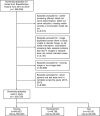Comparison of AI-integrated pathways with human-AI interaction in population mammographic screening for breast cancer
- PMID: 39214982
- PMCID: PMC11364867
- DOI: 10.1038/s41467-024-51725-8
Comparison of AI-integrated pathways with human-AI interaction in population mammographic screening for breast cancer
Abstract
Artificial intelligence (AI) readers of mammograms compare favourably to individual radiologists in detecting breast cancer. However, AI readers cannot perform at the level of multi-reader systems used by screening programs in countries such as Australia, Sweden, and the UK. Therefore, implementation demands human-AI collaboration. Here, we use a large, high-quality retrospective mammography dataset from Victoria, Australia to conduct detailed simulations of five potential AI-integrated screening pathways, and examine human-AI interaction effects to explore automation bias. Operating an AI reader as a second reader or as a high confidence filter improves current screening outcomes by 1.9-2.5% in sensitivity and up to 0.6% in specificity, achieving 4.6-10.9% reduction in assessments and 48-80.7% reduction in human reads. Automation bias degrades performance in multi-reader settings but improves it for single-readers. This study provides insight into feasible approaches for AI-integrated screening pathways and prospective studies necessary prior to clinical adoption.
© 2024. The Author(s).
Conflict of interest statement
P.B. is an employee of annalise.ai. C.W., Y.C., D.J.M., M.S.E., H.M.L.F. and G.C. are inventors on a patent, 'WO2024044815—Improved classification methods for machine learning', a model used in versions of the BRAIx AI reader. The remaining authors declare no competing interests.
Figures




References
-
- World Cancer Research Fund. Breast cancer. https://www.wcrf.org/dietandcancer/breast-cancer/ (2021).
-
- Australian Institute of Health and Welfare. BreastScreen Australia Monitoring Report 2022 (Australian Institute of Health and Welfare, 2022).
Publication types
MeSH terms
Grants and funding
- MRFAI000090/Department of Health, Australian Government (Department of Health)
- MRFAI000090/Department of Health, Australian Government (Department of Health)
- MRFAI000090/Department of Health, Australian Government (Department of Health)
- GNT1195595/Department of Health | National Health and Medical Research Council (NHMRC)
LinkOut - more resources
Full Text Sources
Medical

